Introduction.
It is a pleasure for me to be here this afternoon and to share with you some thoughts about recent macroeconomic developments in China, and I would like to thank the organizers for giving me this opportunity.
In my brief remarks I would like to discuss two interrelated issues which have received considerable attention recently both inside China and in the rest of the world.
The first issue concerns the nature of the current surge of inflation in the Mainland economy. The question that analysts and policy makers have been grappling with is whether this increase is only a consequence of food price increases or whether it is a more general phenomenon.
The second issue relates to the nexus involving currency appreciation, capital inflows, domestic monetary conditions, and inflation. The question here is whether the reserve build-up, fuelled by capital inflows and the current account surplus, has led to too rapid growth in money and credit, hence stoking inflation. Linked to this is the role of the exchange rate of the RMB both as a cause of the problem and a potential solution.
To those of you who are impatient, my answer to these questions are that inflation appears increasingly not to be only a food problem and no, the authorities have not lost control over monetary conditions in the economy and should be able use tools at their disposal to dampen generalized inflationary pressures.
The evolution of inflation.
Chart 1 shows the recent evolution of headline CPI inflation on the Mainland broken down into a food-component and a non-food component. It is of course undeniable that headline inflation is at a high level, certainly beyond the authorities' comfort zone which is sometimes said to have 3% as an upper limit. But note what happens if you strip out the food component. Then the inflation rate drops to less than 2%, a rate that would make the ECB and the Fed very pleased. In fact, as headline inflation has varied quite substantially in the past four years, the ex-food inflation rate has been remarkably stable in the 1-2% range.
Chart 1: Mainland China Inflation rates
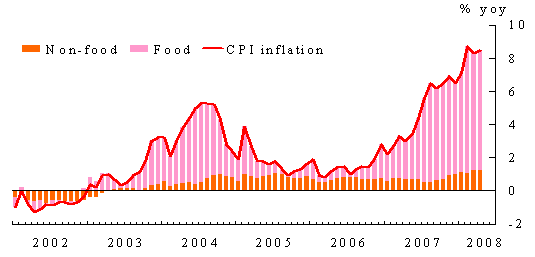
Source: HKMA, Half-Yearly Monetary and Financial Stability Report, June 2008
So should we just not worry? Before attempting to shed some light on this question, allow me to put the issue in a broader regional context.
As you are certainly aware, inflation rates in several economies in the region have increased substantially in the past year. The snapshot presented in this Table 1 shows that some economies have entered the double digit range, and my list does not include countries like India, where the most recent inflation reading was 11%, and Vietnam where inflation has reached over 20% year over year in recent months.
Table 1: Contribution of food to inflation rates in May 2008 (y-o-y)
| |
CPI Inflation |
Food |
Weight of Food |
Contribution of food |
| China |
7.7 |
19.9 |
0.33 |
6.6 |
| Indonesia |
10.4 |
16.5 |
0.35 |
5.7 |
| Philippines |
9.6 |
13.7 |
0.50 |
6.9 |
| Thailand |
7.6 |
11.8 |
0.36 |
4.2 |
| Hong Kong |
5.4 |
11.1 |
0.27 |
3.0 |
| Taiwan |
3.7 |
9.3 |
0.26 |
2.4 |
| Singapore |
7.5 |
8.5 |
0.23 |
2.0 |
| Malaysia |
3.0 |
5.7 |
0.30 |
1.7 |
| Korea |
4.9 |
4.5 |
0.27 |
1.2 |
| Japan |
0.8 |
1.9 |
0.31 |
0.6 |
| |
|
|
|
|
| EU |
4.0 |
7.2 |
0.19 |
1.4 |
| US |
4.2 |
5.1 |
0.14 |
0.7 |
Source: HKMA Staff calculations.
What the table also shows is that much of the increase in inflation is due to the food component. In countries like Indonesia, the Philippines and Thailand the contribution of food prices is well over half of the headline number. Even here in Hong Kong where the headline inflation rate is relatively benign, food price increases are responsible for a substantial portion.
Another aspect of this table is worth noticing. The size of the increase in the food component, col. 3 in the table, varies quite substantially between the economies. China stands out in that its food component has increased almost 20% over the past year, the fastest in the group. This suggests that some of the food price increases are due to local conditions, the infamous pork and chicken prices on the Mainland being a case in point.
Finally, note that the weights of food in the consumer price baskets in the region are substantially bigger than those in the EU and the USA. This makes local economies more sensitive to fluctuation in food prices.
Returning to the question whether we should worry about the high headline inflation numbers given that food inflation is such a large contributor I want to emphasize that I will treat the question from a macroeconomic policy perspective. We do need to recognize of course that higher food prices impose a burden on households, and low-income households in particular as they spend a larger fraction of their income on food. In this sense high and rapidly rising food prices is a worrying development, and it may warrant microeconomic policy attention.
In terms the implication for monetary policy, however, the question we need to consider is whether the difference between headline inflation and 'core' inflation is likely to be resolved by the former converging over time to the latter or the other way around.1
There are at least two aspects to the answer to this question. The first concerns the likely persistence of high food and, I might add, energy inflation. This is a question about the price of food and energy relative to other goods and services. For exhaustible resources like oil it is reasonable to assume that their relative price will increase on a trend basis, but only at a rate close to the real rate of interest, i.e. a few percentage points per year. Clearly the recent upsurge is way beyond what is reasonable in a long-term perspective. Similarly, while it can be argued that the level of food prices will remain higher than we have been used to in the past, the rate of change is unlikely to be sustained at current levels.
To see how important a moderation of food inflation would be for headline inflation rates, consider the consequence of a return of food inflation in China to its average level of the past five years. That average is 8.1% per year. If we assume that non-food inflation is maintained at its current rate, the return of food inflation to this 5-year average would reduce headline inflation to 3.8%, a somewhat high rate but not a number that we would consider alarming.
This of course raises the second aspect of my general question, namely whether the elevated headline inflation rate will feed into wage inflation and thereby increase cost of production, transportation, retail and restaurant services, etc. and thereby increase the non-food component of the CPI. An important question here is how the expectation of inflation, and therefore wage demands and price setting behaviour of firms, will react to high headline inflation.
Absent reliable information on wage inflation and inflationary expectations in the Mainland, we must look at other indicators of general inflationary pressure. I will argue that doing so gives us plenty of reasons not to be complacent.
One reason why we cannot be complacent is illustrated in Chart 2. It shows that prices further up in the production chain are increasing at quite high rates. Whether we look at raw material prices, producer prices, or corporate goods prices we note that they have been rising at increasing rates in the past one to two years. One may legitimately ask whether this pattern will eventually spill over into consumer prices.
Chart 2: Developments of wholesale-type price indices
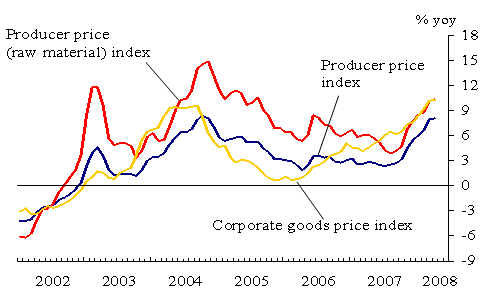
Source: HKMA, Half-Yearly Monetary and Financial Stability Report, June 2008
A simple comparison between the non-food component of the CPI and the corporate goods price index gives some reason for concern. Chart 3 shows that changes in corporate goods prices do seem to translate into consumer price inflation, perhaps with a lag. Formal statistical analysis does indeed suggest this is the case.2 But before we get too alarmed please notice the two different scales in the chart. The corporate goods price index shows much larger variations than the non-food CPI inflation. Therefore we should not conclude that the current ten percent inflation in corporate goods prices will translate into a ten percent CPI inflation rate. A relatively simple regression analysis instead suggests that a pass-through is on the order of 15 percent, implying that a sustained increase of, say, 10 percent in corporate goods prices will increase non-food consumer goods prices by 1.5 percent everything else equal. These calculations point to the possibility that core inflation will increase in the coming months as food inflation may be receding. The headline inflation rate may therefore stay at a relatively elevated level.
Chart 3: Rates of change in corporate goods prices and the non-food component of the CPI.

Source: HKMA Staff calculations.
The appropriate policy response.
Under these conditions, what should be the appropriate policy response? The conventional answer is that central banks should prevent supply shocks from leading to second-round inflationary effects via the expectations and wage channels. In central banks that use the interest rate as an operational target, this typically implies raising the policy interest rate as the ECB has recently done and as financial markets appear to think that the Fed will do sometime between now and the end of the year.
In the case of the Peoples Bank of China (PBoC), the situation is a bit more complicated, not only because the PBoC has more than one target, but also because it has multiple instruments. To explore this further brings me to the second topic of my discussion, namely the nexus between currency appreciation, capital inflows, monetary conditions, and inflation.
An argument which links the four elements proceeds as follows. The observed build-up of foreign exchange reserves leads to an expansion of domestic liquidity unless sterilization policies are pursued aggressively. As international financial integration proceeds, the required sterilization policies become less and less effective and increasingly costly. Money and credit aggregates will therefore increase fuelling aggregate demand and inflation. A solution would be greater flexibility - read faster appreciation - of the RMB.
While this line of reasoning is theoretically correct, I will argue that it does not capture accurately what is actually happening in the economy at present.
International reserves are of cause rising rapidly as this Chart 4 indicates. There are also signs that a substantial part of the increase is due to portfolio capital inflows (the blue bars) allegedly driven by expectations of RMB appreciation.3
Chart 4: Components of the balance of payments and the evolution of foreign exchange reserves.
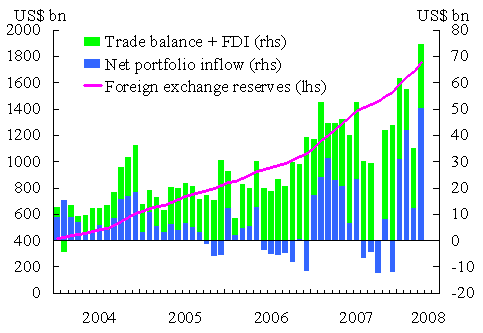
Source: HKMA, Half-Yearly Monetary and Financial Stability Report, June 2008
It is also true that the reserve build-up would lead to a equivalent expansion of reserve money in the economy unless sterilization policies are pursued on a large scale. One element of these sterilization policies consists of selling PBoC bills to the banking system thereby draining liquidity. If one only looks at this aspect of sterilization policy, reserve money growth would evolve according to the black line in the Chart 5. In words, reserve money would be growing at the frighteningly high rate of about 40% per annum. However liquidity in the banking system can also be neutralized by other means, notably by increasing required reserve ratios. And the authorities have done just that as the chart on the right shows. During the past two years required reserve ratios have been increased from 7% to the current level of 17.5%. (Chart 6.)
Once we adjust the reserve money growth for this increase in reserve requirements we obtain the green line in the chart on the left, which shows that the growth of reserve money that banks can use for the purpose of extending loans has been fluctuating around the 10% level for the past several years, hardly an alarming figure in an economy that is growing at a 10% rate in real terms.
Chart 5: Contributions to growth of reserve money.
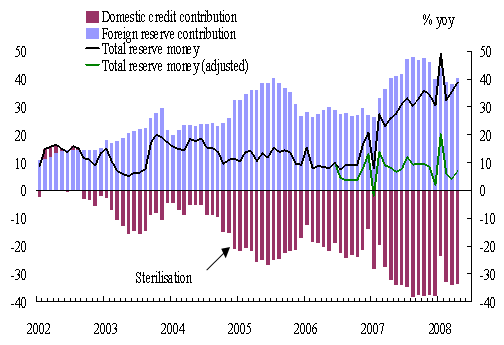
Source: HKMA, Half-Yearly Monetary and Financial Stability Report, June 2008
Chart 6: The evolution of required reserve ration and benchmark interest rates.
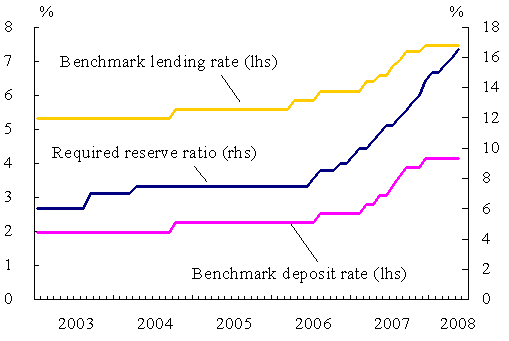
Source: HKMA, Half-Yearly Monetary and Financial Stability Report, June 2008
So as Chart 7 indicates, the authorities have not lost control over the growth rates of monetary and credit aggregates which have not been far from the announced target levels, and which correspond broadly to the nominal growth rate of the economy.
Chart 7: Growth rates of monetary and credit aggregates.
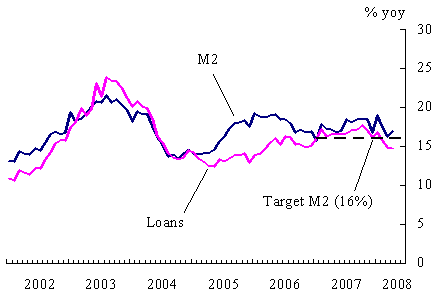
Source: HKMA, Half-Yearly Monetary and Financial Stability Report, June 2008
Arguing that the PBoC has not lost control over the growth of monetary aggregates does not mean, however, that tighter monetary conditions may be not be necessary to cool inflationary pressures. Let us look briefly what policies could be pursued as well as the tradeoffs and constraints associated with their use.
One way to tighten monetary conditions would be the traditional increase in benchmark interest rates. This has of course already been done during the past two years as we have seen in Chart 6. The side effect of such a policy is that it may lead to additional capital inflows as domestic borrowers will find it increasingly profitable to seek funds abroad, and as foreign investors will be attracted by the higher domestic yields. The potentially increased capital inflows will partially offset the effects of the higher interest rates on domestic monetary conditions.
A second policy would be to step up the sale of PBoC bills to drain more liquidity out of the system. As market interest rates are increasing, however, making the bills attractive enough for banks to willingly acquire them will become increasingly costly for the PBoC balance sheet especially taking into account that a significant portion of the assets of the PBoC presumably consists of US government securities the yields on which have declined recently.
Third, reserve requirements could be increased further. This does of course impose a cost on the banking system as the interest rates paid on required reserves - currently 0.9% - is lower than the cost of funds for the banks. This will eventually put a limit on how high reserve requirements can be set.
A fourth possible policy would be to engineer a faster appreciation of the RMB. The problem with this approach is that it would also attract further capital inflows as it increases the relative return on RMB assets and lowers the cost of borrowing abroad. In addition, empirical estimates show that the pass-through of a faster rate of appreciation, and therefore lower import prices, onto the domestic consumer prices is quite limited. Research at the HKMA indicates that a sustained appreciation of the RMB of 10 percent per annum would lower CPI inflation by about 1.5% over a two-year horizon relative to where it otherwise would be.4 It is true that the pass-through to producer prices and corporate goods prices is larger, but as we have already seen, the pass-through from producer prices to consumer prices is only partial. Hence one can not rely on a marginally faster rate of appreciation of the RMB to bring about a meaningful change in the headline inflation rate.
A fifth possibility which has recently been mentioned in the press would be a surprise 'maxi' appreciation followed by a slower or no trend appreciation.5 One consideration that must be taken into account in this case is whether it would really succeed in reducing speculative capital inflows or simply lead to expectations of a further appreciation in the future. In addition, as I have already noted, the direct pass-through of such a policy onto lower domestic consumer price inflation is limited. And finally, it should be kept in mind that a relatively large unexpected appreciation may have financial stability implications depending on the structure of balance sheets of financial institutions, enterprises, and households.
In conclusion, this brief review has shown that there is no simple silver bullet solution to the problem of tightening monetary policy to deal with increased inflation. In addition, as is the case also for other central banks in the present situation, the PBoC is also facing the problem of having to navigate between the Scylla of inflation and the Charybdis of slowing aggregate demand. Difficult tradeoffs indeed.
Summary.
Headline inflation in Mainland China has increased substantially in the past two years. Much of the increase can be attributed to increases in food prices. However, there are signs that more generalized inflationary pressures are building. While the authorities have been able to maintain control on the growth of monetary aggregates by means of sales of central bank bills and, more recently, increases in required reserve ratios, the increase in inflationary pressures may call for additional monetary tightening. Several policy instruments are available, but they all have side effects that may conflict with other policy objectives. In addition, as the external conjunctural environment deteriorates, monetary policy has to weigh the need to fight inflation against the risk that the growth rate of the economy will slow.
1 I am using the concept of 'core' inflation loosely. While there is no universally agreed definition of core inflation, it is often associated with a number one obtains after headline inflation is stripped of the food and energy components.
2 Specifically, using a Granger-causality test it is possible to reject the hypothesis that corporate goods prices do not cause consumer prices. Detailed results are available from the author.
3 It has also been suggested that the trade balance surplus is overstated due to transfer pricing and mis-invoicing.
4 See Chang Shu, Xiaojing Su, and Nathan Chow, "Exchange rate pass-through in Mainland China". Hong Kong Monetary Authority, China Economic Issues, Number 1/08, April 2008.
5 If we use the NDF rate as an indicator of the markets average expectation, currently an appreciation of 1.19% is being priced in at the 3-month horizon. But we can get more information out of market prices. Looking at option contracts on the RMB it is possible to derive an estimate of the maximum appreciation within a 3-month horizon that the market is pricing in. Currently this turns out to be 2.24%. Apparently the idea of a maxi appreciation by the PBoC does not have any currency in among foreign exchange traders.








